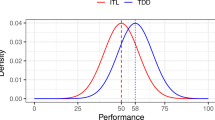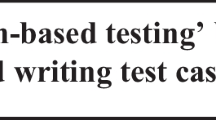Abstract
This article introduces the application of equivalence hypothesis testing (EHT) into the Empirical Software Engineering field. Equivalence (also known as bioequivalence in pharmacological studies) is a statistical approach that answers the question "is product T equivalent to some other reference product R within some range \(\Updelta\)?." The approach of “null hypothesis significance test” used traditionally in Empirical Software Engineering seeks to assess evidence for differences between T and R, not equivalence. In this paper, we explain how EHT can be applied in Software Engineering, thereby extending it from its current application within pharmacological studies, to Empirical Software Engineering. We illustrate the application of EHT to Empirical Software Engineering, by re-examining the behavior of experts and novices when handling code with side effects compared to side-effect free code; a study previously investigated using traditional statistical testing. We also review two other previous published data of software engineering experiments: a dataset compared the comprehension of UML and OML specifications, and the last dataset studied the differences between the specification methods UML-B and B. The application of EHT allows us to extract additional conclusions to the previous results. EHT has an important application in Empirical Software Engineering, which motivate its wider adoption and use: EHT can be used to assess the statistical confidence with which we can claim that two software engineering methods, algorithms of techniques, are equivalent.










Similar content being viewed by others
Notes
Although it is a rare situation, it is feasible to test for equivalence with the null hypothesis as \(H_0: |\mu_T-\mu_R| \le\Updelta\). However, this procedure is rarely used in practice, since it does not allow to control for the “risk of the consumer” (Hauschke et al. 2007, pp. 45-46) therefore rendering the testing for equivalence useless. See McBride (2005, section 5.3) and Cole and McBride (2004) for the practical consequences of this approach.
The value of variable y scaled from range (y min, y max) into range (x min, x max) is given by the transformation
$$ \begin{array}{c} y_{\rm scaled}=y\frac{x_{\rm max}-x_{\rm min}}{y_{\rm max}-y_{\rm min}} +\frac{x_{\rm min}\cdot{y_{\rm max}}-x_{\rm max}\cdot{y_{\rm min}}}{y_{\rm max}-y_{\rm min}}. \end{array} $$
References
Borg, M., & Pfahl, D. (2011). Do better ir tools improve the accuracy of engineers’ traceability recovery? In Proceedings of the international workshop on machine learning technologies in software engineering (MALETS ’11), (pp. 27–34).
Chen, D. G., & Peace, K. E. (2011). Clinical trial data analysis using R. Boca Raton, Florida, USA: Chapman & Hall.
Chow, S. C., & Liu, J. P. (2009). Design and analysis of bioavailability and bioequivalence studies. London: Chapman & Hall.
Chow, S. C., & Wang, H. (2001). On sample size calculation in bioequivalence trias. Journal of Pharmacokinetics and Pharmacodynamics 28(2), 155–169.
Chow, S. L. (1998). Precis of statistical significance: Rationale validity and utility (with comments and reply). Behavioral and Brain Sciences 21, 169–239.
Cole, R., & McBride, G. (2004). Assessing impacts of dredge spoil disposal using equivalence tests: Implications of a precautionary (proof of safety) approach. Marine Ecology Progress Series 279, 63–72.
Cribbie, R. A., Gruman, J. A., & Arpin-Cribbie, C. A. (2004). Recommendations for applying tests of equivalence. Journal of Clinical Psychology 60(1), 1–10.
Dolado, J. J., Harman, M., Otero, M. C., & Hu, L. (2003). An empirical investigation of the influence of a type of side effects on program comprehension. IEEE Transactions on Software Engineering, 29(7), 665–670.
EMA. (2010). Guideline on the investigation of bioequivalence. Tech. Rep. CPMP/EWP/QWP/1401/98 Rev. 1, EMA, European Medicines Agency.
Ennis, D. M., & Ennis, J. M. (2009). Hypothesis testing for equivalence defined on symmetric open intervals. Communications in Statistics—Theory and Methods 38(11), 1792–1803.
Ennis, D. M., & Ennis, J. M. (2010). Equivalence hypothesis testing. Food Quality and Preference 21, 253–256.
Garrett, K. A. (1997). Use of statistical tests of equivalence (bioequivalence tests) in plant pathology. Phytopathology 87(4), 372–374.
Harman, M. (2010). Why source code analysis and manipulation will always be important. In 10th IEEE international working conference on source code analysis and manipulation, Timisoara, Romania (pp. 7–19).
Harman, M., Hu, L., Hierons, R., Munro, M., Zhang, X., Dolado, J., Otero, M., & Wegener, J. (2002). A post-placement side-effect removal algorithm. In IEEE proceedings of the international conference on software maintenance (ICSM 2002), (pp. 2–11).
Harman, M., Hu, L., Zhang, X., & Munro, M. (2001). Side-effect removal transformation. In IEEE international workshop on program comprehension (IWPC 2001), Toronto, Canada (pp. 309–319).
Hauschke, D., Steinijans, V., & Pigeot, I. (2007). Bioequivalence studies in drug development. Methods and applications. New York: Wiley.
Hintze, J. (2000) PASS 2000. NCSS, LLC. Utah, USA: Kaysville.
Hoenig, J., & Heisey, D. (2001). The abuse of power: The pervasive fallacy of power calculations for data analysis. The American Statistician 55(1), 19.
Hyslop, T., & Iglewicz, B. (2001). Alternative cross-over designs for individual bioequivalence. In Proceedings of the annual meeting of the American statistical association.
Lakhotia, K., McMinn, P., & Harman, M. (2009). Automated test data generation for coverage: Haven’t we solved this problem yet? In 4th testing academia and industry conference—practice and research techniques (TAIC PART’09), Windsor, UK (pp. 95–104).
McBride, G. B. (2005). Using statistical methods for water quality management. Issues, problems and solutions. New York: Wiley.
Mecklin, C. (2003). A comparison of equivalence testing in combination with hypothesis testing and effect sizes. Journal of Modern Applied Statistical Methods 2(2), 329–340.
Meyners, M. (2012). Equivalence tests—a review. Food Quality and Preference 26(2), 231–245.
Miller, J., Daly, J., Wood, M., Roper, M., & Brooks, A. (1997). Statistical power and its subcomponents—missing and misunderstood concepts in empirical software engineering research. Information and Software Technology 39(4), 285–295.
Miranda, B., Sturtevant, B., Yang, J., & Gustafson, E. (2009). Comparing fire spread algorithms using equivalence testing and neutral landscape models. Landscape Ecology 24, 587–598.
Ngatia, M., Gonzalez, D., Julian, S. S., & Conner, A. (2010). Equivalence versus classical statistical tests in water quality assessments. Journal of Environmental Monitoring 12, 172–177.
Ogungbenro, K., & Aarons, L. (2008). How many subjects are necessary for population pharmacokinetic experiments? Confidence interval approach. European Journal of Clinical Pharmacology 64, 705–713.
Otero, M. C., & Dolado, J. J. (2005). An empirical comparison of the dynamic modeling in oml and uml. Journal of Systems and Software 77(2), 91 – 102.
Piaggio, G., & Pinol, A. P. Y. (2001). Use of the equivalence approach in reproductive health clinical trials. Statistics in Medicine 20(23), 3571–3578.
Piaggio, G., Elbourne, D. R., Altman, D. G., Pocock, S. J., & Evans, S. J. W. (2006). Reporting of noninferiority and equivalence randomized trials. An extension of the consort statement. The Journal of the American Medical Association 295(10), 1152–1160.
Pikounis, B., Bradstreet, T. E., & Millard, S. P. (2001). Graphical insight and data analysis for the 2,2,2, crossover design. In S. P. Millard & A. Krause (Eds.), Applied atatistics in the pharmaceutical industry with case studies using S-plus (pp. 153–188). Berlin: Springer.
R Core Team. (2012). R: A language and environment for statistical computing. Vienna, Austria: R Foundation for Statistical Computing.
Rani, S., & Pargal, A. (2004). Bioequivalence: An overview of statistical concepts. Indian Journal of Pharmacology 36(4), 209–216.
Razali, R. (2008). Usability of semi-formal and formal methods integration—empirical assessments. PhD thesis, School of Electronics and Computer Science, Faculty of Engineering, Science and Mathematics, University of Southampton.
Razali, R., & Garratt, P. W. (2006). Measuring the comprehensibility of a uml-b model and a b model. In International conference on computer and information science and engineering (CISE 2006) (pp. 338–343).
Razali, R., Snook, C. F., & Poppleton, M. R. (2007a). Comprehensibility of uml-based formal model: A series of controlled experiments. In:Proceedings of the 1st ACM international workshop on empirical assessment of software engineering languages and technologies: Held in conjunction with the 22nd IEEE/ACM international conference on automated software engineering (ASE) 2007, ACM, New York, NY, USA, WEASELTech ’07 (pp. 25–30).
Razali, R., Snook, C. F., Poppleton, M. R., Garratt, P. W., & Walters, R. J. (2007b). Experimental comparison of the comprehensibility of a uml-based formal specification versus a textual one. In B. Kitchenham, P. Brereton, & M. Turner (Eds.), Proceedings of the 11th international conference on evaluation and assessment in software engineering (EASE ’07), British Computer Society (pp. 1–11).
Robinson, A. P., & Froese, R. E. (2004) Model validation using equivalence tests. Ecological Modelling 176(3-4), 349–358.
Robinson, A. P., Duursma, R. A., & Marshall, J. D. (2005). A regression-based equivalence test for model validation: Shifting the burden of proof. Tree Physiology 25, 903–913.
Rogers, J., Howard, K., & Vessey, J. (1993). Using significance tests to evaluate equivalence between two experimental groups. Psychological Bulletin 113(3), 553–565.
Schuirmann, D. J. (1987). A comparison of the two one-sided tests procedure and the power approach for assessing the equivalence of average bioavailability. Journal of Pharmacokinetics and Biopharmaceutics 15(6), 657–680.
Siqueira, A. L., Whitehead, A., Todd, S., & Lucini, M. M. (2005). Comparison of sample size formulae for 2 × 2 cross-over designs applied to bioequivalence studies. Pharmaceutical Statistics 4, 233–243.
Stegner, B. L., Bostrom, A. G., & Greenfield, T. K. (1996). Equivalence testing for use in psychosocial and services research: An introduction with examples. Evaluation and Program Planning 19(3), 193–198.
Stein, J., & Doganaksoy, N. (1999). Sample size considerations for assessing the equivalence of two process means. Quality Engineering 12(1), 105–110.
Tempelman, R. J. (2004). Experimental design and statistical methods for classical and bioequivalence hypothesis testing with an application to dairy nutrition studies. Journal of Animal Science 82(13 suppl), E162–E172.
Tryon, W. W. (2001). Evaluating statistical difference, equivalence, and indeterminacy using inferential confidence intervals: An integrated alternative method of conducting null hypothesis statistical tests. Psychological Methods 6(4), 371–386.
Van Peer, A. (2010). Variability and impact on design of bioequivalence studies. Basic & Clinical Pharmacology & Toxicology 106(3), 146–153.
Waldhoer, T., & Heinzl, H. (2011). Combining difference and equivalence test results in spatial maps. International Journal of Health Geographics 10(1), 3.
Wellek, S. (2010). Testing statistical hypotheses of equivalence and noninferiority, 2nd edn. Boca Raton, Florida, USA: Chapman & Hall.
Westlake, W. J. (1976). Symmetrical confidence intervals for bioequivalence trials. Biometrics 32(4), 741–744.
Yue, L., & Roach, P. (1998). A note on the sample size determination in two-period repeated measurements crossover design with application to clinical trials. Journal of Biopharmaceutical Statistics 8(4), 577–584.
Acknowledgments
The authors are grateful to the reviewers for their helpful comments.
Author information
Authors and Affiliations
Corresponding author
Additional information
The data, R scripts, and other information are available at http://www.sc.ehu.es/jiwdocoj/eht/eht.htm.
Rights and permissions
About this article
Cite this article
Dolado, J.J., Otero, M.C. & Harman, M. Equivalence hypothesis testing in experimental software engineering. Software Qual J 22, 215–238 (2014). https://doi.org/10.1007/s11219-013-9196-0
Published:
Issue Date:
DOI: https://doi.org/10.1007/s11219-013-9196-0




